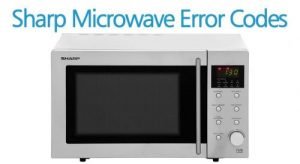
Error codes in microwaves are like the check engine light in your car. They’re there to signal that something isn’t quite right under the hood. The F2 error specifically points to a problem with the microwave’s temperature sensor. Essentially, this means that the sensor isn’t reading the microwave’s temperature accurately, which can lead to your food being undercooked or overcooked. Just like in cars, these error messages are a way for your microwave to tell you that it needs some attention.
You might be wondering whether this issue is covered under warranty. The idea of a warranty is like having a safety net for your microwave. Warranties are promises from the manufacturer that if something goes wrong within a certain time frame and under certain conditions, they’ll fix it for free. But just like any agreement, there are terms and conditions to consider. So, let’s delve into what you need to know about warranties and error codes.
Understanding Sharp Microwave Warranties
When you bought your Sharp microwave, it likely came with a warranty. But here’s the deal: not all warranties are created equal. They vary depending on the model and the region. Typically, Sharp provides a one-year limited warranty for parts and labor. This means if your microwave malfunctions due to manufacturing defects during the first year, Sharp will likely cover it. However, it’s crucial to understand what “manufacturing defects” entail.
A manufacturing defect is when there’s a flaw in how the microwave was built or in the materials used. Think of it like a new car that suddenly stops running because a part wasn’t installed correctly. If your F2 error is due to such a defect, the warranty might cover the repair costs. But if the error resulted from improper use or accidental damage, you might find yourself footing the bill.
It’s important to thoroughly read the warranty details. Check your user manual or Sharp’s website for specifics related to your model. Also, don’t forget to keep your purchase receipt handy. If you decide to pursue a warranty claim, having these documents will expedite your case. The key is being prepared and informed about what your warranty offers.
Causes of Error Code F2
Let’s explore why you’re seeing the F2 error. Usually, this code means there’s a problem with the microwave’s temperature sensor. Imagine the sensor as the thermometer for the microwave, keeping track of how hot things get inside. If this sensor fails, it’s like trying to bake a cake without knowing the temperature of the oven—it just won’t work right.
One common cause of an F2 error is a faulty sensor or a loose connection. Just like a lamp won’t work if the bulb isn’t screwed in properly, your microwave needs all its parts securely connected to function. Another possibility could be a short circuit, which is like a traffic jam in the electrical wiring. When wires touch that shouldn’t, it disrupts the flow of electricity and triggers an error code.
Environmental factors can also play a role. Excessive heat or moisture can lead to problems with the temperature sensor. If your microwave isn’t well-ventilated or if it’s placed in a high-humidity area, these conditions can contribute to the F2 error. In any case, identifying the exact cause often requires professional diagnosis.
Steps to Take When Facing Error Code F2
Now, you’re probably itching to know what to do next. First, consider the age of your microwave. If it’s still within the warranty period, contact Sharp’s customer service. Explain the issue, and they can guide you through the warranty claim process. If you’re outside of warranty, you may choose to hire a professional technician to diagnose and repair the problem.
If you’re tech-savvy and feel adventurous, checking for visible loose connections might not hurt. But remember, microwaves can store electricity even when unplugged, so safety is paramount. Never attempt repairs beyond your comfort level; leave it to the pros.
Seeking preventative measures? Make sure your microwave is placed in a dry, ventilated area. Regular maintenance, like cleaning and inspecting cord conditions, can also prevent future issues. And if you ever have doubts, don’t hesitate to reach out to a professional for advice.
Final Thoughts on Warranty Coverage
The bottom line is that warranties can be a real lifesaver, but they come with strings attached. Understanding what’s covered, and under what circumstances, is crucial. If you’re someone who relies heavily on a warranty for peace of mind, consider purchasing additional coverage if your microwave isn’t already protected.
Remember, dealing with appliances is about being informed and prepared. Keep all receipts, warranties, and user manuals in a safe place. They’re your best allies when technical issues arise. If you ever find yourself lost in the world of microwave error codes, don’t fret. With a bit of research and the right support, you’ll have your device back to heating leftovers in no time.
In conclusion, whether or not the F2 error is covered under warranty largely depends on the specifics of your situation. But with a little digging into your warranty details and a proactive approach, you’ll be well-equipped to handle any microwave mishaps that come your way.